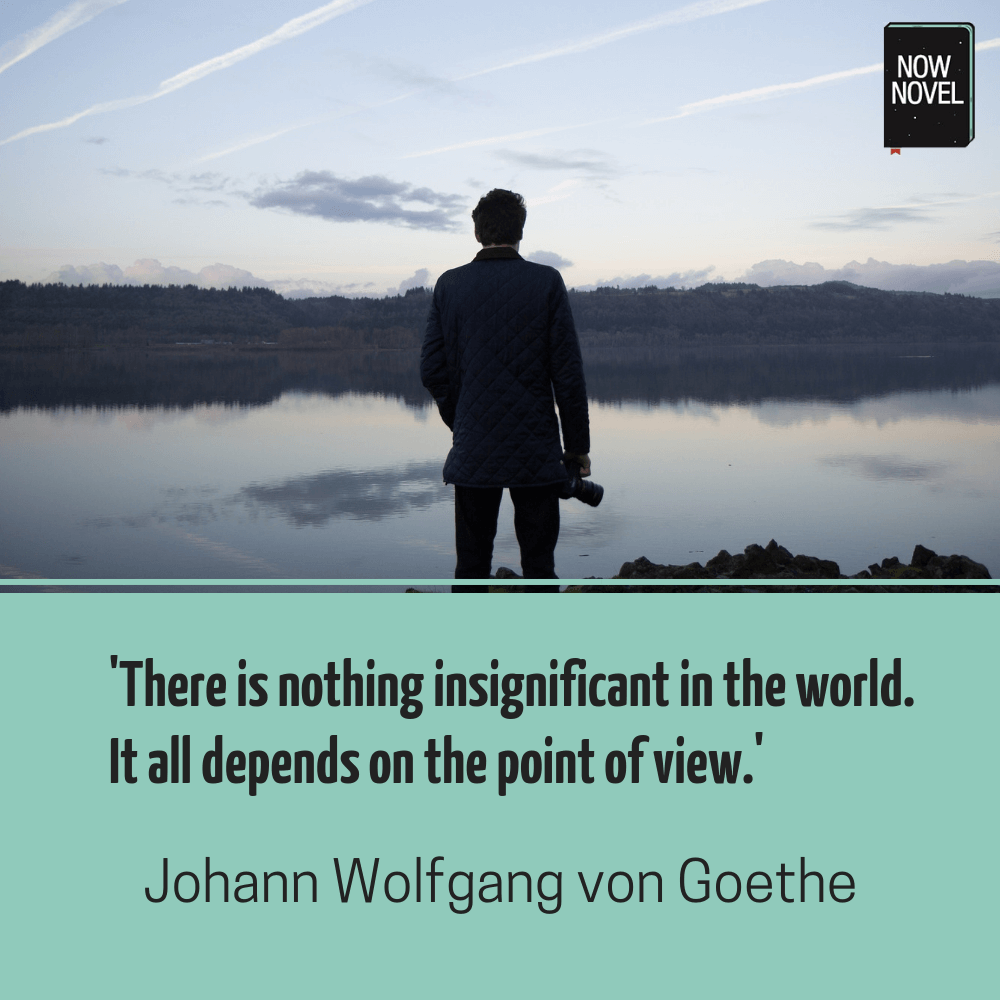‘Point of view’ is an element of writing that confuses many beginning authors. There are various types, from omniscient to limited third person. Dramatic point of view is one such type. Read a definition of dramatic point of view along with examples and tips to help you use this POV well:
What is dramatic point of view?
Also known as ‘objective narration’, dramatic point of view is when the narrator reports the events of a scene without getting inside characters’ private thoughts or feelings. Like a neutral camera without personal feelings, this narration simply records sense data (such as movement, sound, objects, appearances). This leaves the reader to guess what characters may feel.
This viewpoint is also often called ‘fly-on-the-wall’ narration. Like a fly sitting on a wall, it simply ‘takes everything in’ and presents us with what an impartial fly might see.
The term is often used in screenplay writing. We could describe the starting scene of a murder mystery thus:
A thick-set man’s still, naked body lies on slate tiles in a dim bathroom, blood pooling around his head. A nearby window opens onto a narrow balcony. The angled turn of a key in the bathroom door shows it is locked from inside. A woman carrying a letter approaches the apartment’s front door. She knocks twice; listens. After a minute she slides the letter under the door, walks away holding her head down. She turns to look over each shoulder from time to time.
This description of a possible murder scene and a curious action doesn’t give anything away regarding characters’ emotions. It simply observes what a roving camera could. This is dramatic point of view.
How can you use dramatic point of view effectively in storytelling?
1. Use dramatic point of view for mysterious actions and scenes
There are times in a scene where you want to emphasize characters’ emotions and reactions to events. Yet there are also times where establishing the simple facts of plot (the whats and the whys) is important .
To illustrate, the example above focuses our attentions on the unexplained mysteries of the scene. This dramatic point of view example focuses our attention on two (or more) questions:
- Who is the man in the pool of blood (and what happened to him)?
- Who is the woman who leaves a letter and why is she keeping her head down?
Writing expository narration this way is useful because:
- It draws our attention to physical details of setting and action in the absence of emotion
- It makes characters’ feelings about events additional mysteries – we read on to find out the personal effects (and affect, i.e.emotion)
[Get feedback on your latest scene via Now Novel’s critique community, or brainstorm details of plot using our step-by-step story prompts.]
2. Show a scene from a key object’s POV
Dramatic point of view is a narrative device with great creative potential. You can use it to show a scene from an unusual, impartial point of view.
For example, you could narrate the flurry of investigators at a crime scene from the point of view of a piece of evidence (e.g. a letter) that’s fallen behind a wardrobe:
‘Only a thin sliver of movement was visible from where the letter lay unnoticed beneath an Art Deco wardrobe. Feet hurried about, a man’s military boots stopped in the middle of the room and a gruff voice said, “Well shoot, there has to be a lead here somewhere.’
Here, dramatic point of view shows the scene from a key object’s perspective. Because the letter is not a thinking, feeling being (but an inanimate object), it’s fitting that the narration should reflect the at times frustrating indifference of objects. They simply don’t care for our goals, our need for solutions.
When using this point of view, remember to:
- Focus on sense details not emotions: Give neutrally observable facts, not interpretations
- Have a good reason for using dramatic POV: In the example above, making the letter act as the viewpoint narrator, the ‘fly-on-the-wall’, shows the reader pivotal information characters present in the scene don’t know. This creates narrative suspense

3. Show actions and visual clues that develop your story
Using dramatic or objective point of view enables us to highlight perplexing or teasing situations and objects without having to explain them immediately. Objective POV also makes it possible to separate what happens from how characters feel about it, delaying the reader’s full understanding.
These features give you room to play with readers’ expectations and theories about the significance of visual signs you present. In film in particular, it’s a key tactic for creating cinematic suspense.
To take an example, in the reboot of David Lynch’s cult murder mystery TV show Twin Peaks (26 years after it first aired), a student has been paid to watch a mysterious glass box being recorded using video cameras.
In the first scene involving the box, we simply see video cameras recording the blank space inside from multiple angles, and the student observing. We don’t know how the student feels, or the purpose of the box.
The simple act of watching a box creates almost unbearable narrative tension. The objective facts of the scene (the idea of surveillance and the idea of box as a container) give it a creepy, ominous quality. Yet the student does not rub his hands gleefully or quake in fear – the viewer has to interpret what this all means solely in light of visual cues, in terms of what we’ve already seen and whatever will happen next.
David Lynch is a master of using visual signs stripped of immediate, comforting explanations and meanings to unsettle the viewer. Use dramatic point of view to create similar effects in writing. The occasional scene whose implications we don’t yet understand fully as readers may create vivid suspense.
4. Use dramatic point of view for cinematic effect
Dramatic point of view is useful for creating a stark, cinematic effect. It helps to keep your prose clear of exaggerated emotions. These sometimes have the opposite effect to our intent (e.g. scenes of sobs and wails, high drama, can feel overly dramatic).
Consider this example from the opening to Paula Hawkins’ Into the Water (2017):
‘Again! Again!’
The men bind her again. Different this time: Left thumb to right toe; right thumb to left. The rope around her waist. This time, they carry her into the water.
The action is stark, and the use of dramatic POV makes the scene mysterious (apart from the men’s shouts, we don’t know their, or the woman’s, emotions).
Hawkins’ cinematic opening focuses on actions, movements, and simple details of place (e.g. the fact they are near a body of water). This keeps us focused on the subtly drawn violence of the scene, how the simple ‘fly-on-the-wall’ facts of it make us feel. The implied violence produces an unsettling, voyeuristic effect.
As an exercise take a scene of high emotion you’ve written and try to rewrite it completely in dramatic point of view, without including any interpretation or emotion. What is interesting about the scene in purely visual (and other sensory) terms?

5. Mix dramatic point of view with other POVs
It is tricky, of course, to tell an entire story using dramatic point of view. At some point readers will likely want to know how characters feel, how events affect them, personally. To give your narration and the events of your story variety of tone and mood, mix in scenes of action told using dramatic point of view with scenes showing how events spool out into characters’ lives.
For example, after the scene by Paula Hawkins above describing a drowning in eerily neutral terms, we might read a scene showing the severe emotional effects of the girl’s death on those closest to her. Mixing the neutral and the factually interesting with the emotional and personal in this way is one way to give your story ups and downs and an intriguing balance between character and plot.
For another look at how to use point of view, read our definitive guide. Do you need help getting POV in your scenes right? Join Now Novel for constructive feedback from our critique community or work one-on-one with a writing coach to make consistent progress.


8 replies on “Dramatic point of view: 5 tips for fly-on-the-wall scenes”
What genres would you use dramatic pov? Would it be used more in literary genres than commercial? From the studying I’ve done on craft, it suggests using emotion, dialogue, and characterization over exposition. I am a bit confused over when this would be the preferred pov to use. Thank you for your help.
That letter under the desk seemed to be in a thriller, or a murder mystery. I think it could be used in any genre. When do you want to create mystery? When do you want to leave the character’s emotions aside and focus on facts? Look thru some of your favorite books to find scenes written from dramatic pov.
Good suggestion, Jacob. Studying examples is a useful exercise.
Thanks for asking, Rebecca. I wouldn’t say there’s a genre limitation, but if there’s a scene where you want to focus on action or specific details of setting in particular it would work. Although as Jacob points out it’s common in thrillers, espionage novels and the like, you could use it in a romance, too. For example, an enigmatic stranger forgets something behind in a restaurant and a character chases after them to give it back. That brief encounter could be described with a focus on the object more than characters’ feelings if you wanted to convey, for example, how chance and random events can play a big part in how people form connections.
It also is useful for revealing characterization more subtly. You can still have good characterization in dramatic POV, simply by showing what a character says and does without judgment from your narrator. It gives the reader more freedom to decide how they feel (and how characters feel), so I’d suggest experimenting with using it in some scenes and seeing the effect.
Thank you and Jacob for your responses. I am working on a historical mystery and I was wondering about using this for some of the historical parts. It is interesting to me because I haven’t tried it. I hadn’t used present tense before and tried it in a short short story and even though it was so short, it was very challenging. That story is so far my only publication in an anthology.
Hi Rebecca, that’s great it was published in an anthology! Present tense narration is great for creating narrative suspense, as we’re right there in the moment with the character as the scene unfolds. I hope your historical mystery is coming along.
I love experimenting with POV. With deep POV being all the rage these days, it’s refreshing to have more tools in the box to work with.
It is fun! 🙂 Thanks for reading, Karen. I hope your work-in-progress is coming along well.